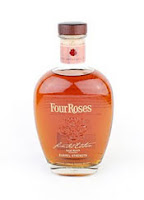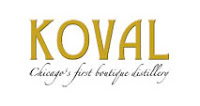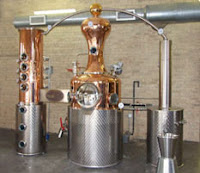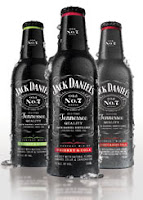
This month's edition of The Whisky Round Table is here! The Whisky Round Table was the brainchild of Jason Johnston-Yellin, who is the author of another one of our 'must read' whisky blogs,
Guid Scotch Drink. His idea was to gather together 12 whisky bloggers from around the world and get them to discuss a whisky topic once a month. The Round Table hosting is passed around the 12 members, with each host setting the question for each month. We are delighted to be part of The Whisky Round Table and are equally as delighted this month, as it is finally our turn to play host.
The subject of our question has been brewing (or should that be distilling!) in our brains for almost a year since The Round Table was started. But we have waited patiently and seen some excellent questions come and go from previous hosts and some great and informative answers from our fellow Whisky Knights. The previous eight Round Tables can be viewed by
clicking here.
For our question, we decided to find out a inner secret of each of our fellow Round Table members and we have received some entertaining and humorous answers (and one particularly different one from someone with a highly vivid imagination ...
keep taking the medication, Joshua!). After all, it's a post-festive, bleak and depressing time of the year (for those of us in the northern hemisphere and especially in the UK - where is the sun?), so we thought that it was time for something a little more light hearted. We hope that you enjoy the following replies to our question ....
What is your whisky 'dirty little secret'? That's the whisky that you always enjoy but would never let your 'whisky connoisseur' friends know that you do (apart from us!). It is the big brand/well known name that you may drink when out or the one that always sits in your whisky cupboard, alongside your limited edition cask strength bottlings from those niche distilleries. Tell us why it is your 'dirty little secret' whisky, as we like a good story._________________________________________________
 Chris
Chris >
www.nonjatta.blogspot.comThis really is dirty. Filthy. Sometimes, when out and about in Tokyo's impossibly hot and sticky summer, I have been known to buy a whisky highball in a can. Yes, you read that right: a can. It can be surprisingly refreshing, but it is the lurid depravity of drinking "whisky" out of a can that makes it a special and unspeakable experience.
(
Thanks to Chris for sending us this photo ... it looks alright to us!)
Mark >
www.glasgowswhisky.comI have a bit of a whisky-fetish for Abhainn Dearg, which seems to be a spirit (almost typed 'whisky' there - oops!) that many whisky drinkers dismiss as being a bit rough and ready. Funnily enough that's exactly why I like it. Here is a bit of history in a glass: illicit-style stills churning out handmade spirit in a distillery that was built in an old salmon hatchery (and not too far from an original illicit still...). In fact they are now using an old illicit still that previously sat out in front of the distillery! If you get the chance to visit you will find, at the end of a long and winding road, a couple of ramshackle buildings in the middle of nowhere surrounding by rolling hills and facing long, golden sands and clear blue sea. I'm just dying to go back.
Since that's not really controversial then I'll admit that in the height of summer, if we get one, I'll sometimes be tempted by a nice, refreshing G&T. I probably shouldn't have said that, but snobbery in drinks is a bad thing so let's not frown for too long, eh?
Gal >
www.whiskyisrael.co.ilWell, I usually drink single malts and not many blends, but there are two wee blends that i am quite fond of, from my early days of whisky drinking. The first is Teacher's Highland Cream. While not extra complex, it's a very nice blend, that offers a wee bit of smoke, and malty notes as well. I enjoy it quite a bit from time to time.
The other one is also a cheapish blend named "Islay Mist" (the basic NAS version), which contains quite a bit of Laphroaig. I used to like this one very much before i become addicted to fully blown peat monsters. it's quite peaty, and not delicate as some other Islay featured blends tend to be (Black Bottle for example), and it was priced reasonably even in Israeli standards.. I no longer have a bottle of this handy, but hey, it makes a mean cocktail base, if you'd like to add some peaty stuff to your cocktail world...
Both have a warm corner in my heart, and when no one is watching, i may sneak a dram or two of those ... Shhhh... don't tell anyone eh?
Keith >
www.whisky-emporium.comHa, trust our Knightess to be the one asking about our "dirty little secrets", as if we have any, or would even own up to them. I mean, do you think I go around trying cheap, own label supermarket brands in my 'Cheapo Challenges'? Do you think I enjoy these? Although I must admit all four in my 'Four for €40' were surprisingly drinkable.
There's also Kilbeggan, currently priced around €14 and certainly the older label (until 2010) was great value rather than a dirty little secret. In fact brilliant value! Now, don't tell anyone, this is just between the three of us, right? But every year I look forward to the latest An Cnoc vintage release, which is usually an excellent dirty little secret, sorry, good value!
But possibly my dirtiest little secret of all is the main ingredient for my hot toddies which I use in attempts to fight off dreaded colds. What is it? Ssshhhhh, don't tell anyone, but I tend to use Grant's Family Reserve blended whisky. Dirty little secrets? Nah, don't know what you mean ;-)
Neil >
www.caskstrength.netAh! The classic 'guilty pleasure'...or to put it another way- the whisky equivalent of Phil Collins, Roxette or driving a Vauxhall Cavalier.
To be honest, we don't have a single whisky in our possession that we would be uncomfortable to happily tell people about- from super cheap blends (sure there's a bottle of '100 Pipers' round here somewhere) to bizarre Lithuanian attempts at single malt - they're all worthy of being guzzled. However, if we have one guilty pleasure (Joel's tartan under-garments is another matter) it would be occasionally drinking a light and crisp Lowland style single malt (like Glenkinchie 12yo) with a mixture of ice and sparkling water, topped with a hint of tonic and a slice of lemon zest. What sacrilege!!
Try it, and we can feel utterly sordid, but ultimately satisfied together!!
Chris >
www.edinburghwhiskyblog.comWhen I first read this question, I wondered what Matt and Karen were looking for. Were they asking if secretly I had a passion for blends? But then I thought, surely that can't be a "dirty little secret". Blends finance the industry. Maybe instead I could admit that really I enjoy Absolut, (I don't, but say for arguments sake) but just the other day there was an article in Just Drinks extolling the virtues of Vodka as a stepping stone to the darker spirits. I suppose if I made my own Whisky in my basement and drank it, that would be a "dirty little secret" (I don't, in case any local constabulary are reading this)
When I think about what my dirty little secret is, I have to think of something that caused me some apprehension when telling my Scotch Whisky loving friends and their reaction to the revelation. When I thought like this, I hit on my "dirty little secret". Jameson Irish Whiskey! I absolutely love the stuff. I have always enjoyed the standard expression and since our absolutely brilliant trip to Midleton, I really love the aged stuff. The flavour really appeals to my sweet tooth. I am actually just ordering my second bottle of the 18 year old. The history of being so close to closure in the sixties and rising from the ashes, really enhances my respect for them as a company. Most of my friends are huge Scotch fans, so turning up to the pub in a Jameson Rugby top caused some consternation.
So there we are. My dirty little secret. It feels good to get it out. Thank you to Matt and Karen for helping us all admit our "dirty little secrets". It's like group therapy.
Joshua >
www.jewishsinglemaltwhiskysociety.comInteresting question! Perhaps the toughest one yet seeing that it's no secret I have a love for entry level/easy to come by whiskies; especially the Glenmorangie Original! What may shock you, however, is how I came to love the Glenmorangie Original. Until now, I've never told a soul. Actually, this is not true. I told my story once but sadly, I had to kill the recipient of this tale as she swore she would leak it to the world! Sorry dead ghost-type lady - you know who you are!
Today, however, is a new day and I am ready to tell my story to the world. You'll just need to watch your backs after reading this! Just kidding. I PROMISE not to be the one that makes you take the big nap or the dirt sleep (to use the parlance of your time).
My name is not Joshua Hatton. My true moniker is H.G. Wells, born in Bromley, Kent, UK, 1866. Author and inventor of a Time Machine. What??? You thought my book was fictional?? Ha! No good folks, my story was a fictionalized biography or sorts. I am about to tell you what really happened (but can not put it into book form so I will summarize as best I could):
A) I invented a time machine. B) I travelled into the future! Booyah!! C) I did not find a civilization of two hostile species however, I found that the world of whisky was segregated into shit blends and few, if any, good single malts.
This would not do!! This could not happen to the future! My children and grandchildren needed better malts and better blends to enjoy! Secretly being an illicit distiller myself and tasting my good whiskies from the late 1800's I knew I needed to go back in time to fix things right quick!
I travelled back to the 1700's and I decided to act as a consultant to all Scottish distilleries to help them produce good malts (and grain whiskies). I then fast forwarded to the 1800's as well, 1843 to be exact, and founded Glenmorangie. I found some fantastic long swan-neck shaped stills that used to produce gins killed the owners of those stills and began to produce malt whiskies in Tain (sorry dead ghost-type gin producers - you know who you are!!).
Glenmorangie, by the way, actually means the "Glen of the SuperJew, Joshua Hatton" (my new alias). It was my opus and we made some good whiskies, aye. That is until 1995/1997 when I distilled what would soon become 2007's "Glenmorangie Original". A layman's whisky more awesomer than my silly time machine!
So, why is the Glenmorangie my favorite?! Because, good people, as I have told you, I created the stuff. And because of the consulting work I did throughout the centuries, you all can thank me for the good blends out there (thank John Glaser too as that dude knows what he's doing with his Compass Box whiskies! Another love of mine...). Now, I have to kill you. Just kidding...
Peter >
www.thecasks.comHmmm...well, I do have a soft spot in my heart for semi-decent, cheap bourbons like Old Crow, but I haven't had a bottle of that stuff around since the half-pint I bought to torture myself all for the sake of a post a few months back. Come to think of it, I still have half of that half pint left...
The only bottle that fits this description that makes a near regular appearance in our cabinet at home would be Bulleit Bourbon. In the States at least, it's oval-shaped bottle and off-center orange label are pretty much ubiquitous in any bar or supermarket you walk in to. It holds a special place in my heart because it, uh, figured pretty heavily into one of my wife's and mine early dates. There used to be a great neighborhood bar on San Francisco's Potrero Hill called Sadie's Flying Elephant where we ended up one night after a nice dinner and well, one Bulleit led to another and we decided that the dark little table we were at was the perfect place to "steal a few furtive kisses". Being the kind and sensible souls that we are, we realized that such passionate displays of activity (such as they were) were perhaps not to the liking of the more Victorian patrons of the bar. So, after clearing most of the bottle, we decided to move to greener, more comfortable pastures.
Unfortunately, as we were leaving, one of these aforementioned prudish barflys decided to offer his slurred critique on my technique and proposed that he and I engage in some rudimentary contests of strength. Now, for those that know me, you know that I'm a lover not a fighter...mostly by default, as I come in around 150 lbs and have arms like toothpicks. In a fight with me, there'd be two hits, me hitting you and me hitting the ground, wincing in pain as I cradle my broken hand. Luckily, I was able to see my peril through the Bulleit-y bourbon-y haze, and though my date might have found fisticuffs romantic, I opted to take the high road which, not coincidentally, is also often the less painful road in these types of circumstances. I forfeited the match, and instead got to walk my girl home where, after biding her a chaste goodnight, proceeded to woo her with sonnets up to yon window.
Oh, stop cringing, you asked for a good story about a dirty little secret whisky. Bulleit is always welcome in our home as a reminder of those lusty days of misspent (relative) youth. It doesn't hurt that it's a well-priced, really quite good, super-high-rye-content bourbon made, believe it or not, by the Four Roses Distillery.
Dan & Mike F >
www.whiskyparty.netMike F > Wild Turkey 101 Kentucky Straight Bourbon Whiskey: if it’s on my shelf, it won’t stay there long, and if I’m at the bar, it works every time. The price is around $25 for a liter, but at over 100 proof, you’re getting an awful lot of bang for your buck. Irrespective of value, it’s really an excellent 8 year old bourbon, having been distilled at a lower proof and barrelled with very little water. As well, the higher bottling proof gives it versatility. Neat it’s full of spices, vanilla, and oak tannins, and it can really help put a dent in your liver. For a casual dram or to stretch your barroom dollars you can add loads of water without over-diluting it, producing a sweeter, honeyed profile with notes of maple syrup and oranges. It also makes some mean cocktails, and so it’s always the life of the party.
Dan > Johnnie Black. Though I think that it probably wouldn't be derided by the whisky community, Johnnie Black is my "dirty" secret. It's EVERYWHERE, so even if I go to somewhere that only offers three whiskies, I know I can get it (or Dewar's white label or Johnnie Red). It's a satisfying if simple drink, providing sweetness and smoke, all in an inoffensive 40% mix. I've gotten used to drinking it neat out of plastic cups, gibraltar glasses, and even my nosing glasses at home. It's something friends recognize, so when they won't appreciate a 27 year old cask strength because it might be too harsh or not name brand enough, they'll appreciate the Johnnie Black, and I can know that I'm not doing them a disservice and helping them realize that scotch can be drunk without soda.
Jason >
www.guidscotchdrink.comThis is a great question and a perfect way to begin 2011, however, my mouth is big enough and my confidence solid enough that I don't have any whisky secrets, "dirty" or otherwise. I broke my whisky cherry, so to speak, with Glenfiddich's entry level dram. Back when Morrison's was still Safeway I drank Safeway's own Islay single malt (Bowmore from 1998-2000, apparently) while a student in Aberdeen. I still greatly enjoy mystery-name releases: Ellenstown; Classic of Islay and Isle of Skye. I confidently tell whisky newbies that, if they like smokey whisky, Laphroaig 10 year old will be one of the best whiskies they every purchase, and it's cheap as chips. I'm even working on enjoying more blends. Compass Box's blended releases might be too good and too expensive to be kept as a "dirty" secret but Arran's Robert Burns Blend was a very pleasant surprise when I tasted it for the first time a couple of weeks ago and I wouldn't think twice about adding a bottle or two of that to my collection (less than $30 a bottle in the US and under £15 in the UK).
If I was to delve down really deep, though, in an attempt to satisfy the salacious curiosity of this month's hosts, this Scots lad who currently finds himself living in the US might just admit to developing a taste for American rye whiskey. However, the stuff I've really been enjoying is in the $100 range. That's a lot of Bowmore Legend!
Ruben >
www.whiskynotes.beI’m afraid I don’t have secret bottles or dirty preferences, although my cupboard contains a few bottles that make me wonder why on earth I’ve bought them (Pittyvaich Flora & Fauna, Islay Mist and a few sulphury or wine finished monsters). Those were clearly beginners mistakes. On the other hand, my biggest little secret would probably be that I’ve never visited a distillery in Scotland. I don’t try to hide it in any way, but yes, I have the feeling it occasionally causes a worried look in the eyes of connoisseurs. In my defense, I do know a few things about the process of distillation and many of its parameters (albeit in a slightly theoretical way). Also, the Scottish weather is too similar to our Belgian weather to persuade my girlfriend of its holiday potential. Anyway, I‘m seriously planning a trip now, so ask this question again within a few months and I’ll probably have to think about another little secret...
______________________________________________________
So finally, what of our 'dirty little whisky secret'? Well, we have been known to enjoy plenty of things that we shouldn't (and yes, we are talking about whisky!) but none more so than the much maligned Jack Daniel's. The famous Old No.7 outsells any other American whisky, and most other whiskies for that matter, by the shipload (yes, that does say ship ...) and it's distinctive advertising can be seen all over the world. Despite this, it seems to have a poor reputation and is seen as nothing more than a mixing companion of cola or the cure for a depressingly bad day (think of all those movie clichés where someone is seen swigging from a bottle of Jack to try and 'make things better').
Jack Daniel's seems to lead most people to assume the classic "it's popular therefore it can't be any good, can it?" But isn't the opposite true? Isn't something popular, or becomes popular, by being of an acceptable quality in the first place and easily available so that lots of people buy it? OK, the current marketing juggernaut doesn't help the public's perception of Jack Daniel's, but we think their whiskies, especially the more limited releases, are all pretty good and quite under rated ... and we mean to drink straight and not just with cola. The sweetness of the regular Old No.7 is simply delicious and quite refreshing.
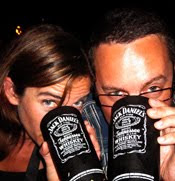
Having said that, one of our favourite ways of drinking Old No.7 is with cola and especially from a pre-mixed can. We first tried this at a music festival in Spain a couple of years ago (pictured,
left) and despite paying far too much for it, we haven't looked back since! The feeling of 'dirtiness' soon passes, especially after a couple more cans and some good music!
We all having 'secrets' but if you enjoy drinking something - popular, big brand, cheap blend, single cask single malt from a little known cult distillery or otherwise - then don't worry what other people think and just enjoy it. Because, do you know what? Many others will be enjoying it too.
 Tyrconnell is a single malt Irish whiskey that is currently made by the award winning Cooley distillery in County Louth, approximately half way between Dublin and Belfast. The name is taken from the Irish Gaelic 'tír Chonaill' which translates as 'land of Conaill' (the 'Conaill' in question was an ancient ruler of the north western part of Ireland) and the whiskey is named after a racehorse of the same name. This horse famously won a race in Ireland in 1876, despite being a 100-1 shot and is depicted on the packaging.
Tyrconnell is a single malt Irish whiskey that is currently made by the award winning Cooley distillery in County Louth, approximately half way between Dublin and Belfast. The name is taken from the Irish Gaelic 'tír Chonaill' which translates as 'land of Conaill' (the 'Conaill' in question was an ancient ruler of the north western part of Ireland) and the whiskey is named after a racehorse of the same name. This horse famously won a race in Ireland in 1876, despite being a 100-1 shot and is depicted on the packaging.




